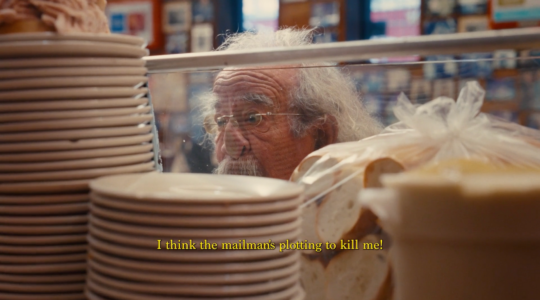Sometimes the best Jewish stories begin at the end. In the Warsaw Ghetto it was the saddest night of the year, Tisha b’Av, synonymous with fire and loss. It was the start of the Great Deportation, a 12-week stretch that would see 265,000 Jews stuffed into boxcars bound for Treblinka. It was a time for burial, not the burial of bodies — bodies were burnt, not buried, where those boxcars were going — but a burial of Jewish stories, song lyrics, Nazi edicts torn down from lamp-posts, chasidic teachings, diaries, theater programs, and even Yiddish candy wrappers, the proof of life.
One Ghetto Jew left a note to a stranger, along with his buried sheaves of paper: “When you find this … there may be no more Jews in Poland. There may be no more Jews in Europe. There may be no more Jews in the world…”
The burials were the work of Oyneg Shabes, a secret underground of 60 writers and archivists personally selected by Emanuel Ringelblum, a young Zionist with a then-rare doctorate in Polish-Jewish history. He’d been intrigued by an earlier Jewish historian, Simon Dubnow, who in 1891 urged the Jews of Eastern Europe to start collecting documents, curios, evidence of their lives, a movement known in Yiddish as zamling (“to collect”).
After decades of near obscurity, the story of Oyneg Shabes (the underground’s code name, and the Yiddish transliteration of Oneg Shabbos, the traditional Sabbath hour for camaraderie, stories and song) is being told in a new feature-length film, “Who Will Tell Our History.” Roberta Grossman, director, writer and producer, said that after discovering Samuel Kassow’s 2009 book, “Who Will Write Our History?” (the book has a question mark, the movie doesn’t), she became determined to turn it into a film. Grossman, 60, has a lengthy Jewish resume, having directed documentaries such as “Hava Nagila (The Movie)”; “Blessed Is the Match: The Life and Death of Hannah Senesh”; and “Above and Beyond,” about the early days of the Israeli air force. That film, like “History,” was executive produced by Nancy Spielberg, among others, with a budget of under $2 million. That includes a grant from brother Steven Spielberg’s Righteous Persons Foundation, established with the profits from “Schindler’s List.”
In 1939, with the Nazi invasion of Poland, Ringelblum sensed the magnitude of the moment and started a journal. When the Ghetto was sealed on Nov. 15, 1940, he brought zamling to the Warsaw Ghetto, handpicking writers and collectors from every walk of Jewish life, from rebbes to artists, from smugglers to professors. A few days later, on a Shabbos afternoon, with everyone confidently greeting each other, “Good Shabbos!” “Good Shabbos!” the first meeting of Oyneg Shabbos convened in Ringelblum’s apartment.
If this was the end of the Jewish story, as it seemed for Polish Jews in 1940, it was a story Ringelblum wanted Oyneg Shabes to tell, not the Nazis. In the Ghetto, only Nazis had photographers and cinematographers were creating documentaries, forcing Jews into indignities for propaganda films. But maybe, someday, Ringelblum thought, someone will find the Oyneg Shabes collection and know that once there was a people…
Two caches of what Oyneg Shabes buried were found in 1946 and 1950. A third batch is thought to be buried beneath the Chinese Embassy, where it remains to this day, the Chinese reportedly refusing to allow an archaeological expedition under their embassy’s foundation.
Director Grossman, speaking to us from Paris, said, “I’ve spent a great part of my now long life reading and learning about the Holocaust. I thought I was fairly well-versed, but I never heard about Oyneg Shabes. Their story is the most important unknown story of the Holocaust. Ringelblum was a great hero. The members of Oyneg Shabes were extraordinary.”
The film is a docudrama, but “I hate that word,” says Grossman. “It evokes bad television, something less than cinematic, falling between the emotional pull of a drama and the gravitas of a documentary. I prefer to think of this as a hybrid film — a documentary with dramatic scenes.”
Grossman said, “As a documentary filmmaker I get to dig into the cinematic toolbox and pull out the things that work to tell the story.” The 95-minute film, in black-and-white and color (including vivid color film of Warsaw Jews pre-war), blends German documentaries of the Ghetto to establish scenes, along with Polish actors portraying Jews in situations that took place in private. Sometimes the actors are inserted, Zelig-like, in the documentary footage.
“We went to extreme lengths of time and expense,” said Grossman, “to make sure everything was as historically accurate as possible: every fabric, every pen, every wallpaper — and every word and scene comes directly from the Oyneg Shabes archive. We didn’t make anything up.”
Ringelblum was the director of Warsaw’s Aleynhilf (Self-Help) group, running soup kitchens, orphanages, and shelters. Ringelblum’s day job proved quite convenient for Oyneg Shabes. As a sanctioned Jewish organization, it was a place for Oyneg writers to get notebooks, pencils, and even a salary
Support the New York Jewish Week
Our nonprofit newsroom depends on readers like you. Make a donation now to support independent Jewish journalism in New York.
Rachel Auerbach, a Jewish journalist in the 1930s, and a rising star in Warsaw’s Jewish intelligentsia, planned to leave Warsaw when war came. Some of the Jewish elite managed to leave the city, but Ringelblum, whom she knew casually, urged her to stay and work in one of his soup kitchens. “We can’t all run away,” he told her.
Ringelblum had his eye on Auerbach for Oyneg Shabes and he needed a good writer in the soup kitchen. After all, every day, in came hundreds of Jews with unique stories to tell, each working a different job, each from different blocks in the Ghetto. Kitchens were places where people talked. In a ghetto of hunger, kitchen workers always had a bowl of soup. It kept Auerbach from starving, and it gave her plenty to write.
Everywhere, the Jews were subjected to indignities and humiliations, with a ferocity and sadism arguably surpassing what had become the norm in Germany. In the winter winds, “Jewish women were seized for labor,” wrote Ringelblum in his diary. Other Jewish women, still wearing fur coats, were stopped in the street by Nazis, given buckets of water, “ordered to wash the pavement with their panties and put them on again, wet.”
Ringelblum was a tough editor. All Oyneg Shabes writings and reports had to be approved by him. Ringelblum was passionately in love with the Jewish people, but not sentimental. Kassow wrote, Ringelblum believed that Jewish histories had to retain their professional integrity, as only histories based on high standards could ultimately stand the test of time.” He urged his writers “to reveal the negative along with the positive, and let the chips fall where they may.” The bottom line for Ringelblum: “Everything is important. Nothing is unimportant. Write down everything you see. Everything that you hear.” And so Oyneg Shabes collected poetry, the songs of beggars and jesters, sermons and reports from underground schools.
Ringelblum wrote, “The watchword was … to live with honor and die with honor.” Orthodox Rabbi Simon Huberband was recruited to collect information about religious Jews in the Ghetto. There were no longer conventional kashrut questions, after all, there was no milk or meat, but there were questions on seders without matzah, and questions about death, burial, and mourning. One report, “Kiddush Hashem,” noted the Jews who were martyred while defending other Jews or holy items.
As time went on, Oyneg Shabes, hearing of the first systematic gassings in Chelmno, realized that the Germans were shifting from torture to genocide. Now, says Kassow, the Oneg Shabes agenda changed from zamling “to something totally new and horrible: the documentation of mass murder.” One member of Oyneg Shabes stopped writing in Yiddish and started writing in Hebrew, as if his writing had to move moved into the realm of the Biblical, a modern Book of Lamentations.
One Jew who escaped Treblinka snuck into the Warsaw Ghetto for the sole purpose of giving information about the death camp to the historians at Oyneg Shabes. They drew a full map of the camp with information about every building in Treblinka. Oyneg Shabes, through the Polish underground, sent a message to the BBC which broadcast on June 26, 1942: “We will now broadcast a special program about the horrific bestialities that the Nazi occupier is perpetuating on the Jews… the Germans have murdered about 700,000 Polish Jews in all.” Oyneg Shabes members were thrilled — the outside world was paying attention, it might make a difference! It didn’t.
https://youtu.be/WpXB2UruoUc
“Who Will Write Our History” will be playing in the New York area on Jan. 17, 3:30 and 8:30 p.m., at the New York Jewish Film Festival (Walter Reade Theater, 165 W. 65th St., filmlinc.org); Jan. 18-20 and 27 at Quad Cinemas in Manhattan (quadcinema.com); Jan. 23-24 at the Marlene Meyerson JCC Manhattan (334 Amsterdam Ave., jccmanhattan.org); Jan. 27 in Glen Cove, L.I., at the Holocaust Memorial and Tolerance Center of Nassau County (hmtcli.org); and Jan. 30 at the United Nations. Grossman added that on Jan. 27, International Holocaust Remembrance Day, there will be 200 screenings in 34 countries.
The New York Jewish Week brings you the stories behind the headlines, keeping you connected to Jewish life in New York. Help sustain the reporting you trust by donating today.




